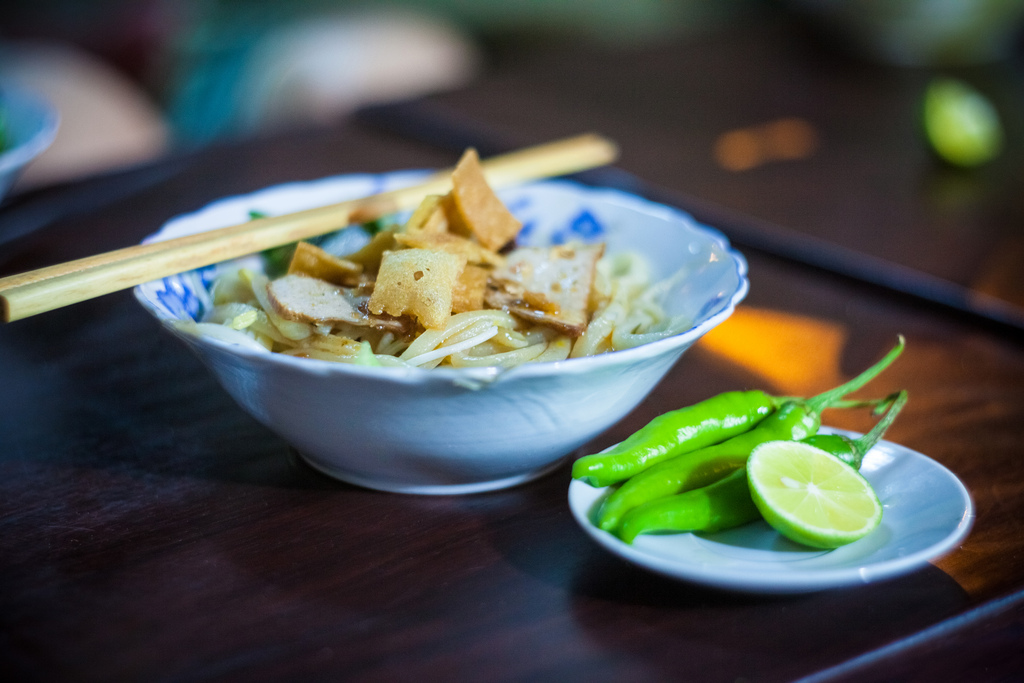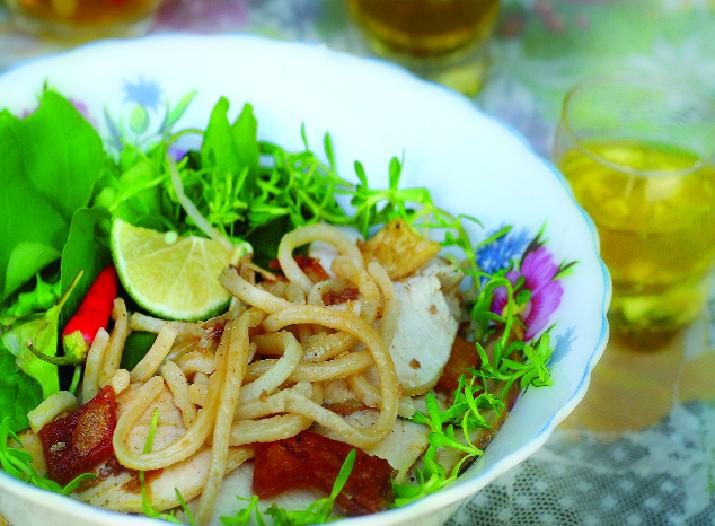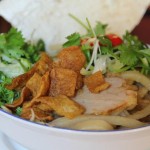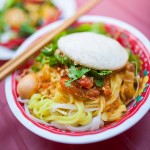Cao Lau Hoi An
Cao Lau hoi an is the foremost traditional food in Hoi An. Cao Lau does not taste like any other Vietnamese dish, but nobody can really recognize it as being comparable to Chinese or Japanese cuisine. Despite its Chinese-like appearance, the Chinese people don’t consider it to be Chinese food. Until now, the origin of Cao Lau is still enveloped mystery.
 Cao Lầu is a specialty dish of Hoi An
Cao Lầu is a specialty dish of Hoi An
How does Cao Lau look like?
Cao Lau comprises of the signature cao lầu noodles, slices of barbecue pork, pork crackling, bean sprouts, lettuce and herbs, it is then finished with a spoonful of stock. Cao lau noodles are carefully made from local fresh rice (not older grains of rice).
What make Cao Lau so special?
The dish cannot be replicated outside of the town because the water used in the dish must be drawn from a well in the nearby Ba Le well which is dug by the Cham people, which is at the end of an alley opposite 35 Phan Chau Trinh Street. The lye solution used to prepare the noodles comes from trees grown on Cham Island. This water is then mixed with ashes from certain trees, to give it its particular yellow tinge and slightly firm texture. The noodles will therefore be soft, enduring and flavored with special sweet-smelling additives.
How to cook Cao Lau
The meat used to prepare the Cao lau must be pork loin or trotter. The pork is fried in a marinade and then roasted for 1 hour. Next, fish sauce, soy sauce, garlic, sugar, salt & pepper, thin crispy croutons, vegetables, bean sprouts and spices are thrown in, and after adding the noodles and herbs the dish is done. With a hint of spice, simple and yummy.
The dry pancakes used must be thick and have a lot of sesame. Greasy coconut essence and bitter green cabbage are also indispensable. The so-called genuine Cao lau Hoi An must satisfy all the above requirements. It was said that only some wells in Hoi An were used to make Cao Lau noodles. What is more, only some Hoi An families were able to produce Cao Lau in their own traditional way, but the quality was not as good as it used to be before.
Where to try Cao Lau in Hoi An
Visitors to Hoian who want to eat truly authentic cao lau should seek out the only cao lau street vendor on Nguyen Hue street. She is an old woman who’s been selling cao lau on this street for more than 20 years. Her place is always crowded from 3:00pm to 4:30pm.
Thuy
Add: Corner of Trân Phú & Hoàng Diệu Street (across Mermaid Restaurant – 2 Trân Phú St)
Opening hours: 6am – 2pm
Cao Lầu is 20000 vnd (AU$1)/dish
CAO LAU RECEIPT
1. Water source:
In Hội An (Faifo) and other surroundings such as Thanh Hà, there still remain the wells in the old square that the Cham people dug from hundreds of years. Water from these wells is used for drinking and cooking, and it has a unique flavor. The most famous well is the Bá Lễ well.
2. Lye solution:
Lye is made from the ashes of trees. Different trees give different lye solutions. The particular lye solution that is used to make cao lầu’s noodle is from “tro” tree grown in Cham Island nearby.
3. Rice:
The rice to make cao lầu’s noodle is of the local rice variety. The rice used is neither freshly harvested nor too aged. The rice is washed, soaked in Hội An’s well water and lye solution. After that the soaked rice is ground into a thick paste and poured into cotton bags to drain excess water. The paste becomes dough, and is kneaded. The thin dough is briefly steamed, cut into strings, and steamed again until the noodle becomes completely cooked. The noodle is left in open air for its surface to dry. When used, the noodle is blanched briefly in hot water. Cao lầu’s noodle has more texture and doesn’t have a sour flavor of the more regular rice noodle.
 Visitors to Hoi An always remember Cao Lau, which is special symbol for Hoi An.
Visitors to Hoi An always remember Cao Lau, which is special symbol for Hoi An.
4. Xá xíu-Translation:
this is the Vietnamese pronunciation of Chinese barbecue pork, char siu
About 500g lean pork butt, cut to about 5cm thick. Mixture: 5g Chinese five-spice powder + 1/2 teaspoon salt + 1/4 teaspoon ground pepper + 1 tablespoon minced garlic + 2 tablespoons soy sauce. Marinate the pork in the mixture for 40 minutes. Heat a small pot on low heat, add 2 tablespoons of cooking oil, and pan fry the pork a little, then add boiling water to cover the meat. You can also use coconut juice instead of water. The pork should now be tender. When used, slice it into thin pieces.
5. Stock:
Cook 500g of pork bones in 3 liters of water and 100 dried shallots. Simmer and skim the fat often until about 2.5 liters stock is left. Remove the bones and shallot from the stock. Season the stock with salt and MSG (Oriental food, of course!) to taste.
6. Pork rind:
Select the thinnest pork skin, and remove all the fat. Cut the skin to small pieces of about 2 cm wide, and marinate for 30 minutes in the same kind of mixture you use to make xá xíu. Deep fry the pork rind until crispy. Let the pork rind drain.
7. Herb:
Húng lủi (Mentha aquatica L.; water mint), cut to short stems. Chive, minced. Cilantro also
8. Presentation:
Put noodles and water mint in a bowl. Place slices of xá xíu on top. Throw in some pork rind and minced chive. Pour just a little of the stock into the bowl. Also throw in some cilantro on top. Throw in a dash of pepper.
Post Views:
28,363






